Yet there’s a hill village in southern Spain where the light rarely switches off and “For Sale” signs still start with a five. The map keeps overlooking it. The sun doesn’t.
I arrived just as the baker slid the last tray of sugar-dusted rosquillas into the window and the square tipped from cool shadow into full white glare. Dogs padded between chairs, their paws clicking on old stone, and an old miner’s cart rusted quietly beside a fountain. On a wooden door, a handwritten card: Se vende. 85.000 €. A motorbike coughed up the lane, then the silence came back like someone closing a soft door. This is the kind of light that makes time slow down. The price tag on the door made me stop.
The white village that forgot to get expensive
Bédar clings to a shoulder of rock above the Almería coast, a white swirl of houses and ironwork balconies that still feels like a place, not a theme park. From the top street you can see the sea, a hard strip of blue that looks close enough to touch, even though the road winds for twenty minutes before Mojácar. **Houses here still list for less than the price of a London car parking space.** The lanes are narrow, the conversations are long, and the postman knows who actually lives behind each door.
At Café Miramar, Marta keeps three spoons on every saucer because someone always joins your table. She points at a terrace opposite where a couple from Leeds wave down. They paid €88,000 for a two-bed with a roof terrace and a lemon tree in a paint tin. The bus to the beach comes twice in the morning and once in the afternoon, which suits them fine. They say they swim in October and eat tomatoes that taste of the sun, which is a cliché until you bite one.
Almería province quietly tops Europe’s sunshine charts, often scraping 320 days of clear or mostly clear skies while the rest of us argue about umbrellas. Prices stayed sane because the coast soaked up the frenzy and the interior never learned to shout. There’s no big resort, no golf course with a Latin name, no homogeneous new build estate to inflate the baseline. What there is: older townhouses with thick walls, terracotta floors, some with a good roof and some with a roof that wants your attention. The value sits in corners and views, not glossy brochures.
Buying under £100k without frying your savings
Start with the bones of the house: structure, roof, orientation. A south-east terrace buys you breakfasts in winter sun and afternoons in gentle shade. Look for “casa de pueblo” listings in Bédar, El Pinar and Serena, a trio of villages strung along the same ridge, where 70–95k still finds two bedrooms and a slice of sky. Get your NIE number early, line up a local gestor, and bring a handheld moisture meter. **Buy the bones, not the staging.** The lemons in the bowl don’t come with the deed.
The biggest mistake? Falling for the Instagram view and ignoring the north wall that sweats in January. Feel walls with your palm, flush loos, run taps, listen for the pump. Ask about IBI (council tax), basura (rubbish fees), and comunidad costs if it’s an apartment; those small lines become big if you forget them. You’ll want €5–10k on top for deeds, taxes, and a bit of electrician time. Let’s be honest: nobody actually does that every day. Yet one slow morning with a notebook and a flashlight saves a season’s worth of swearing.
People here will tell you two things with the same shrug: don’t rush, and don’t wait forever.
“We traded a Hackney rent for a mortgage smaller than our old gym membership,” laughs Lucy, a designer who moved up from the coast. “Sun at breakfast, stars at night, and I can hear owls instead of mopeds.”
- Turn the shower on full blast and check the pressure doesn’t die after 30 seconds.
- Stand in the middle of each room and check your phone signal and 4G speed.
- Open the roof hatch at midday and feel the heat under the tiles with your hand.
- Walk the street at night to see where people park and where noise travels.
Could this be your quiet reset by the Med?
You don’t need a sea-view penthouse to feel the Mediterranean work its slow magic. A tiled step, a metal chair, a glass of something cold at six, and the rosy clatter of neighbours arguing about onions will do. We’ve all had that moment when a place taps your shoulder and whispers, You could stay. The question is whether the rhythms here fit yours: late dinners, warm winters, a town where nothing much happens and you start to notice everything. **Almería has the kind of dry, punchy sunshine that laughs at umbrellas.** It lightens your packing list and your mood. What if it also lightened the pressure you carry around with you?
| Point clé | Détail | Intérêt pour le lecteur |
|---|---|---|
| Sunshine | Almería province often clocks around 300–320 sunny days a year | Long outdoor season, lower heating costs, better winter quality of life |
| Property | Two-bed village homes in Bédar area still list under £100k | Entry point to Mediterranean living without wrecking your budget |
| Access | Almería airport ~55 mins; Alicante and Murcia within 2–3 hours | Multiple flight options for family visits and flexible travel |
FAQ :
- Where exactly is this “hidden” village?Bédar sits in the hills of Almería, Andalucía, about 20 minutes inland from Mojácar and the Mediterranean. Elevation brings breeze and views, while the coast stays close enough for a swim before lunch.
- Can I live here year-round as a Brit post‑Brexit?You get 90 days in any 180 on a standard tourist stay. Longer stays need a visa, often the Non‑Lucrative or Spain’s newish Digital Nomad route for remote workers. A local gestor can walk you through documents and timelines.
- What does under £100k actually buy?Think two bedrooms, one bathroom, a workable kitchen, sometimes a small patio or roof terrace. Many places are liveable now and want light upgrades, not deep renovations. The unicorns exist, but the sweet spot is “honest and fixable.”
- What’s the cost of living like?Coffee hovers around €1.50–€1.80, a beer with a tapa can still be €2–€3, and seasonal veg is cheap at the weekly market. Fibre internet is available in and around the village, and electricity bills soften with all that sun.
- Is it safe, and who actually lives there?Crime is low, gossip is high, and the mix is Spanish families, retired miners, a handful of remote workers, and long‑term expats who chose here over the crowded coast. Fiestas are loud, generous, and involve everyone.










Sold. Trading drizzle for 300 days of sun and a lemon tree on a roof terrace sounds like the dream. If Bédar still has two-beds under £100k, I’m booking a flight. Any estate agents you’d actually trust there? 🙂
This sounds idyllic, but what’s the catch? After fees and taxes, does “under £100k” still hold, or do you end up at £110k? Also, how brutal are August temps—tempertaure spikes over 40°C? Water security, reservoir levels, wildfire risk? I’m cautious but curious.